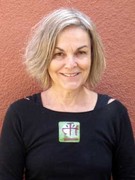Start Now - May is Mental Health Month
MENTAL HEALTH MONTH
Mental Health Month has provided an opportunity to raise awareness about mental health issues for over 50 years. Mental Health America launched Mental Health Week, which eventually became May is Mental Health Week, in 1949. Each May, Americans recognize Mental Health Month with events and activities in communities across the country. The theme for Mental Health Month this year is “Get Connected” to emphasize the important role of social relationships in protecting and improving mental health and building resiliency.
There are now designated times in May for groups to raise awareness and advocate for improvements in research, prevention and treatment on specific mental health issues. The first week in May, for example, has been designated as Children’s Mental Health Week. But the specific times are not as important as educating about all mental illnesses any time of the year.
Mental Health Ministries is featuring several downloadable resources that may be helpful in your planning. Many of our free print resources are available in Spanish.
May is Mental Health Month can be used as a bulletin insert or flyer. Also available in Spanish.
Mental Illness in Children and Adolescents can also be used as a bulletin insert or handout. Also available in Spanish.
Guidelines for Organizing a Successful Conference gives tips on organizing a conference, seminar or workshop. (PDF, English / PDF, Spanish)
Children’s Mental Health Week is a bulletin insert using the green ribbon symbol
HAITI - THE EMOTIONAL AFTERSHOCK
We have all been deeply affected by the devastation in Haiti. Many of us made donations to groups that were able to get much needed food and medical services to the Haitian people. It will take years before Haiti can rebuild.
After the initial calls for basic needs, persons working in Haiti called for mental health professionals to begin to meet the psychological trauma…the emotional aftershocks.
The emotional aftershocks of the tragedy in Haiti can also affect persons in this county who are vulnerable because of past traumatic experiences. The November e-Spotlight featured some resources on trauma. I want to list up again the Sidran resource, Risking Connection in Faith Communities…A Training Curriculum for Faith Leaders Supporting Trauma Survivors.
The five propositions around which Risking Connection in Health Communities is organized are: I1) The experience of trauma can wound human beings in six major realms, many of which affect the formation of relationships; (2) Relationships are central to healing from trauma; (3) Because humans are spiritual beings, trauma affects our relationship with God, and our relationship with God contributes to our healing from trauma; (4) Those who help trauma survivors will also be personally affected by the survivor’s experience and response to the trauma; and (5), Communities in general, and faith communities in particular, extend the web of relationships, both with others and with God. For information on this book and training opportunities, visit http://www.riskingconnection.com/.
After the November e-Spotlight I heard from some of you with other resources on trauma. Joyce Boaz sent some articles from the website, Gifts From Within, http://www.giftfromwithin.org/html/articles.html#spirit
on PTSD and spirituality.
MENTAL ILLNESS AND FAMILIES OF FAITH: THE CHALLENGE AND THE VISION
I have written a four session resource/study guide for clergy and communities of faith in response to the many questions and requests for information that I receive from persons who want to include spirituality as an important part of the treatment and recovery process.
Surveys show that over forty percent of Americans seeking help with mental health issues turn first to ministers, priests and rabbis. This is twice as many as those who went first to a psychiatrist, psychologist or family physician. Unfortunately, the response of clergy and congregations falls significantly short of what parishioners expect of their faith leaders. Individuals struggling with mental illness are significantly less likely to receive the same level of pastoral care as persons in the hospital with physical illnesses, persons who are dying or those who have long-term illnesses. Mental illness has been called the “no casserole disease.”
This resource is designed to be used with clergy, members of congregations, family members and anyone desiring to learn more about mental illness and how to respond with compassion and care. It can be used as a small group study or leaders can adapt it to use in an extended class or seminar. Faith leaders can use this guide to quickly find information on a specific topic when the need arrives.
The four sections included in this resource/study guide include:
- Understanding Mental Illness
- The Unique Role of Faith Communities
- Creating Caring Congregations
- Help for Faith Leaders.
This is a FREE resource that can be downloaded on the Mental Health Ministries website as a PDF document. Click here to download this new resource.
2010 NAMI NATIONAL CONVENTION
The NAMI national convention will be held in Washington D.C. on June 30-July 3, 2010. This gives you the opportunity to be part of the July 4th celebrations in our nation’s capitol! The theme for this year’s conference is Recovery and Reform: The Road From Here. More information and registration forms are available at www.nami.org/convention.
The NAMI FaithNet Advisory Committee’s proposal to offer a workshop on “How to Get Started” has been approved. Nancy Kehoe, author of Wrestling With Our Inner Angels, will be presenting a 90 minute symposium on the important role of spirituality in dealing with mental illness.
For further updates and resources for May is Mental Health Month, you can subscribe to the NAMI FaithNet e-newsletter at http://www.nami.org/faithnet to received information on resources on ways to educate about mental illness in our faith communities.
PATHWAYS TO PROMISE CONFERENCE DOWNLOADS
Presentations from the national summit, Companions on the Road to Recovery from Mental Illness: Pathways for the 21st Century, held in October of 2009 in St. Louis, MO., are now available on-line as free downloads. The conference agenda is posted on http://www.pathways2promise.org/ with embedded links to some 20 of the presentations from the conference.
ARTICLE - HOW CATHOLICS STRUGGLE WITH MENTAL ILLNESS
Mental illness is still murky territory for those who experience it, their families, and their church. An article called Through a Glass Darkly: How Catholics Struggle with Mental Illness available at http://www.uscatholic.org/node/5811
SNIPPETS FROM SUSAN
There are times in our lives that are so significant that they become delineators between before and after…births, deaths, marriages and other major events. The fall of 1991 was one of those life changing events with my first hospitalization for severe clinical depression.
Despite my seminary classes in pastoral counseling, I had no idea what was happening. It was a frightening time for my family as we struggled to understand my illness. Because of the stigma and shame, and the very real fear of losing my job as a pastor, we hid my illness from the congregation for two years. My family suffered in silence.
Things have gotten better over the years, but many clergy and faith letters remain silent about mental illness or see it as a moral or spiritual failure.
A few weeks ago I had lunch with a colleague who I had not seen for five years. We had a lot of catching up to do as we shared our ministries. He was surprised to learn that I was no longer serving a church but I had started a ministry to create resources to help reduce the stigma of mental illness in our faith communities.
There was a pause in our conversation. He said, “I have been struggling with depression for almost a year but haven’t told anyone in my congregation.” I related how I kept my illness a secret from my congregation for two years and how my family and I suffered in silence and how sharing my story opened the door to moved the community to begin to create a caring congregation.
My colleague was not ready to share his illness but wanted to know how to begin to talk about mental illness in his congregation. I suggested that he simply include “persons with a mental illness and their families” in his pastoral prayer next Sunday.
The following Monday I received a call from my colleague saying that, to his amazement, three parishioners had come up to him to share their struggles with serious mental illness. He said, “I didn’t think anyone in my congregation had a mental illness.” I encouraged him, when he was comfortable, to share his story with the congregation. I also shared ways he can begin to educate about mental illness.
I pray for the time when individuals and families living with a loved one with a mental illness will be silent no more.
Rev. Susan Gregg-Schroeder
Coordinator of Mental Health Ministries
6707 Monte Verde Dr.
San Diego, CA 92119
http://www.mentalhealthministries.net/








